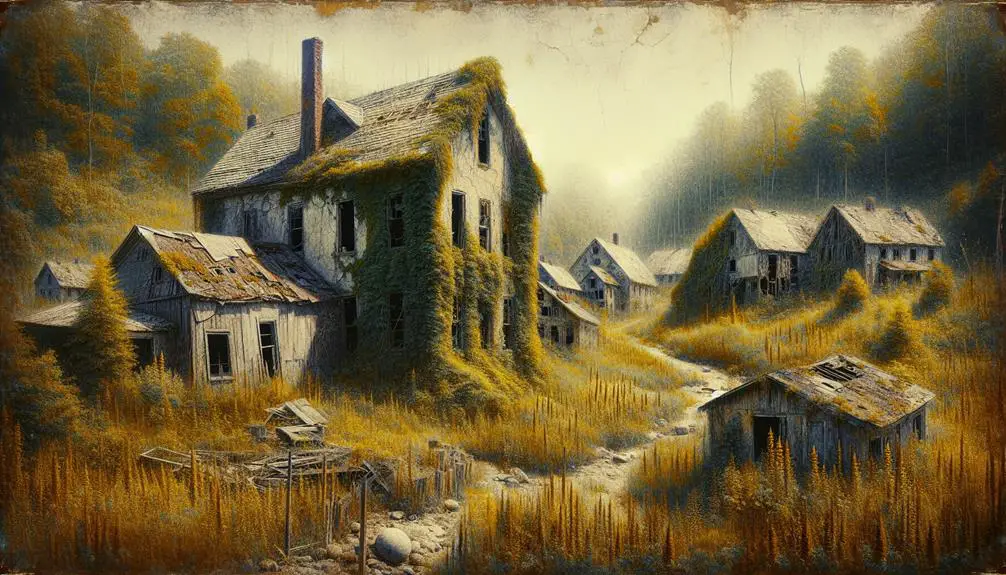Discover the 7 best abandoned utopian communities in the US! From New Harmony, Indiana's educational focus to Oneida, New York's communal living experiment, each site offers a peek into unique social ideals. Explore Amana Colonies' agricultural heritage and Brook Farm's transcendentalist roots. Examine Koreshan State Park's gender equality vision and Nauvoo, Illinois' significant Mormon ties. Llano Del Rio in California showcases sustainable farming practices. Each community holds a rich history waiting to be explored further.
Key Points
- New Harmony, Indiana: Model community for education and equality, faced internal conflicts.
- Oneida, New York: Practiced communal living, emphasized social and economic equality.
- Amana Colonies, Iowa: German Pietist settlement showcasing agricultural heritage.
- Brook Farm, Massachusetts: Based on transcendentalist principles, valued communal living and equality.
- Koreshan State Park, Florida: Founded for communal living, gender equality, and scientific exploration.
New Harmony, Indiana
New Harmony, Indiana, once a bustling utopian community, now stands as proof of the fleeting nature of idealistic endeavors. Founded in 1814 by a group of intellectuals aiming to create a harmonious society, this social experiment was envisioned as a model community for education, science, and equality. Despite its noble intentions, internal conflicts and financial struggles led to its eventual decline.
Today, New Harmony serves as a reminder of the challenges faced by historic preservation efforts. The town's unique history and architectural heritage make it a valuable site for understanding past social experiments. Preservationists work tirelessly to maintain the original structures and artifacts, allowing visitors to glimpse into the ambitious dreams of its founders.
As you explore the streets of New Harmony, you can't help but feel a sense of awe at the grandeur that once was. The faded facades and overgrown gardens whisper tales of a bygone era, where visionaries dared to dream of a better world. Witnessing the remnants of this utopian vision, you're reminded of the fragile nature of idealism and the importance of learning from past endeavors.
Oneida, New York
Explore the unique history of Oneida, New York, a fascinating utopian community known for its communal living practices and legacy of perfectionism.
Learn about how the residents of Oneida aimed for social and economic equality through shared work and resources.
Discover the challenges and triumphs of this experimental society as we investigate the ideals that shaped its existence.
Oneidas Communal Living
Located in Oneida, New York, the Oneidas Communal Living community thrived in the mid-19th century with its unique social and economic structure. Oneida's philosophy centered around complex marriage, where partners were chosen based on compatibility rather than traditional notions of monogamy. This approach aimed to foster equality and eliminate jealousy within the community.
Communal practices at Oneida emphasized shared work responsibilities and resources, promoting a sense of unity and cooperation among its members. Residents engaged in various industries like silverware production, ensuring self-sufficiency and financial stability. The community's focus on progress and innovation led to the creation of successful businesses.
Despite its eventual dissolution, Oneidas Communal Living serves as a fascinating example of a historical experiment in alternative living.
Legacy of Perfectionism
The legacy of perfectionism at Oneida, New York, reflects a fascinating historical experiment in communal living that emphasized ideals of equality and innovation.
Perfectionist ideals were central to the community's ethos, promoting shared work and resources, gender equality, and complex marriage practices. This commitment to perfectionist principles had a significant societal impact, challenging traditional norms and fostering a sense of unity among members.
The community's emphasis on social harmony and cooperation contributed to its overall success and longevity. Despite the eventual dissolution of the commune, the legacy of perfectionism at Oneida continues to inspire discussions on alternative lifestyles and the pursuit of utopian ideals in modern society.
Amana Colonies, Iowa
Nestled in the heart of Iowa, the Amana Colonies stand as proof of a unique communal lifestyle that once thrived in the United States. Established by German Pietists in the 19th century, the Amana Colonies showcase a blend of Agricultural Heritage and Cultural Preservation. The community's agricultural roots are evident in the well-preserved farms and fields that dot the landscape, reflecting the self-sufficient nature of the colonists who lived there.
Cultural Preservation is at the core of the Amana Colonies, with historic buildings, traditional crafts, and communal practices that have been maintained over time. Visitors can explore the seven villages that make up the colonies, each offering a glimpse into the past way of life that once defined this utopian community.
Whether you're drawn to the history of communal living or simply seeking a peaceful retreat, the Amana Colonies provide a fascinating look into a bygone era of American society. Immerse yourself in the simplicity and harmony of this abandoned utopian community, and discover the enduring legacy it has left behind.
Brook Farm, Massachusetts
Journey to Brook Farm in Massachusetts to discover the fascinating history of another abandoned utopian community in the US. Established in the 1840s, Brook Farm aimed to establish a harmonious society based on transcendentalist principles. This community valued intellectual pursuits, equality, and communal living.
Historic preservation efforts have been made to protect the remaining structures at Brook Farm, allowing visitors to get a glimpse of its past. The site offers a unique opportunity to explore the remnants of this once-thriving utopian experiment.
Agricultural practices were central to life at Brook Farm. Residents engaged in farming activities, aiming for self-sufficiency and sustainability. They believed that working the land together fostered a sense of unity and purpose among community members.
Today, Brook Farm stands as a tribute to the utopian ideals that once flourished within its grounds. Visitors can wander through the preserved buildings and reflect on the aspirations of those who sought to create a better society through collective effort.
Koreshan State Park, Florida
Discover the intriguing history of Koreshan State Park in Florida, a unique site that offers insight into another abandoned utopian community in the US. Founded by Dr. Cyrus Teed in the late 19th century, the Koreshan Unity movement aimed to create a society based on communal living, gender equality, and scientific exploration. The community thrived for several decades, attracting followers seeking alternative lifestyles and spiritual enlightenment.
Today, Koreshan State Park stands as a confirmation of the ideals of its founders. The park not only preserves the natural beauty of its surroundings but also serves as a reminder of the community's commitment to environmental preservation. Visitors can explore the historic buildings, gardens, and trails that once housed a thriving utopian society.
While the Koreshan Unity movement eventually disbanded, the legacy of their beliefs lives on through the park's dedication to sustainability and harmony with nature. As you wander through the grounds, you can't help but feel the echoes of a bygone era when dreams of a better world were alive and thriving.
Nauvoo, Illinois
Nauvoo, Illinois holds a significant place in history due to its ties to early Mormon settlers and their ambitious community-building efforts.
The challenges faced by these settlers in planning and sustaining their utopian vision offer valuable insights into the complexities of communal living.
Exploring the historical significance and planning obstacles of Nauvoo sheds light on the realities faced by those endeavoring to create ideal societies.
Historic Significance of Nauvoo
Why does Nauvoo, Illinois hold such significant historical importance?
Nauvoo was established as a Mormon settlement in the 1840s, a time when the followers of Joseph Smith faced severe religious persecution. Here are four key reasons why Nauvoo's history is essential:
- Religious Sanctuary: Nauvoo provided a safe haven for Mormons fleeing persecution, allowing them to practice their faith freely.
- Economic Hub: The community thrived economically, becoming one of the largest cities in Illinois at the time.
- Cultural Center: Nauvoo was a center for arts, education, and innovation, reflecting the Mormons' commitment to community-building.
- Political Influence: The Mormons' presence in Nauvoo shaped local and state politics, leaving a lasting impact on the region's history.
Community Planning Challenges
Handling the urban development challenges in Nauvoo, Illinois requires a strategic approach that balances historical preservation with modern community needs. Urban design in Nauvoo must honor the city's unique history while also catering to the contemporary demands of its residents.
Preserving the architectural integrity of the historic district while integrating new infrastructure poses a significant challenge. Social dynamics play an important role in community planning, as the needs and preferences of the population must be considered when making decisions about development.
Striking a balance between honoring the past and embracing the future is essential for sustainable growth. By engaging with the community and understanding their evolving needs, Nauvoo can navigate these challenges and create a harmonious blend of old-world charm and modern functionality.
Llano Del Rio, California
Nestled in the Mojave Desert of California, Llano Del Rio stands as a reminder of a once-thriving socialist utopian experiment. Founded in 1914, this community aimed to create a society based on cooperation and equality. Today, its remnants offer a glimpse into a unique chapter of American history.
Here are four intriguing aspects of Llano Del Rio:
- Sustainable Agriculture: The community prioritized sustainable farming practices, utilizing the desert landscape to grow crops and raise livestock. This focus on self-sufficiency was central to their vision of a harmonious society.
- Architectural Ruins: The architectural remains at Llano Del Rio tell a story of grandeur and aspiration. From the crumbling foundations of communal buildings to the eerily beautiful structures left behind, the site evokes a sense of both loss and wonder.
- Social Experimentation: Residents at Llano Del Rio sought to challenge traditional capitalist structures through communal living and shared resources. Their bold experiment sheds light on alternative ways of organizing society.
- Legacy of Idealism: Despite its eventual decline, Llano Del Rio's legacy endures as a symbol of idealism and the pursuit of a better world.
Frequently Asked Questions
What Were the Main Reasons for the Eventual Decline and Abandonment of These Utopian Communities?
You'll notice that the main reasons for the decline and abandonment of these utopian communities often revolved around internal social dynamics, conflicts, economic challenges, and failed leadership. These factors led to disillusionment and eventual disbandment.
How Did the Residents of These Communities Sustain Themselves Economically and Socially?
You sustained yourselves economically through communal farming and crafts, sharing resources for mutual benefit. Social dynamics thrived as residents worked together, held meetings to discuss community matters, and organized events to foster unity and camaraderie.
What Impact Did These Abandoned Utopian Communities Have on the Surrounding Areas and Communities?
As you explore the impact of abandoned utopian communities on surrounding areas, you'll find a mix of economic shifts and cultural influences. These unique experiments often left lasting imprints, shaping the fabric of nearby communities.
Were There Any Attempts to Revitalize or Repurpose the Abandoned Structures Left Behind in These Communities?
When exploring abandoned utopian communities, you may discover various renovation projects and community gardens. Art installations breathe new life into forgotten spaces, promoting sustainable living ideals while preserving history. Revitalizing these areas offers a glimpse into the past with modern twists.
Have Any Modern-Day Attempts Been Made to Recreate or Re-Establish Similar Utopian Communities in the Us?
In the quest for perfection, modern-day revival of utopian experiments echoes past dreams. Despite challenges, you explore new ways to create ideal communities. Dare to envision, innovate, and build a future utopia.



